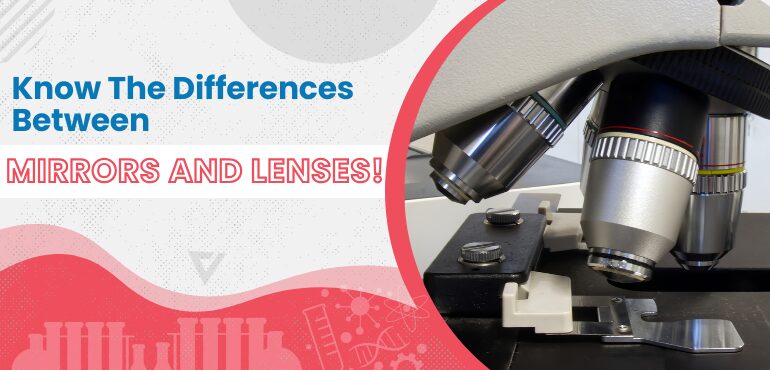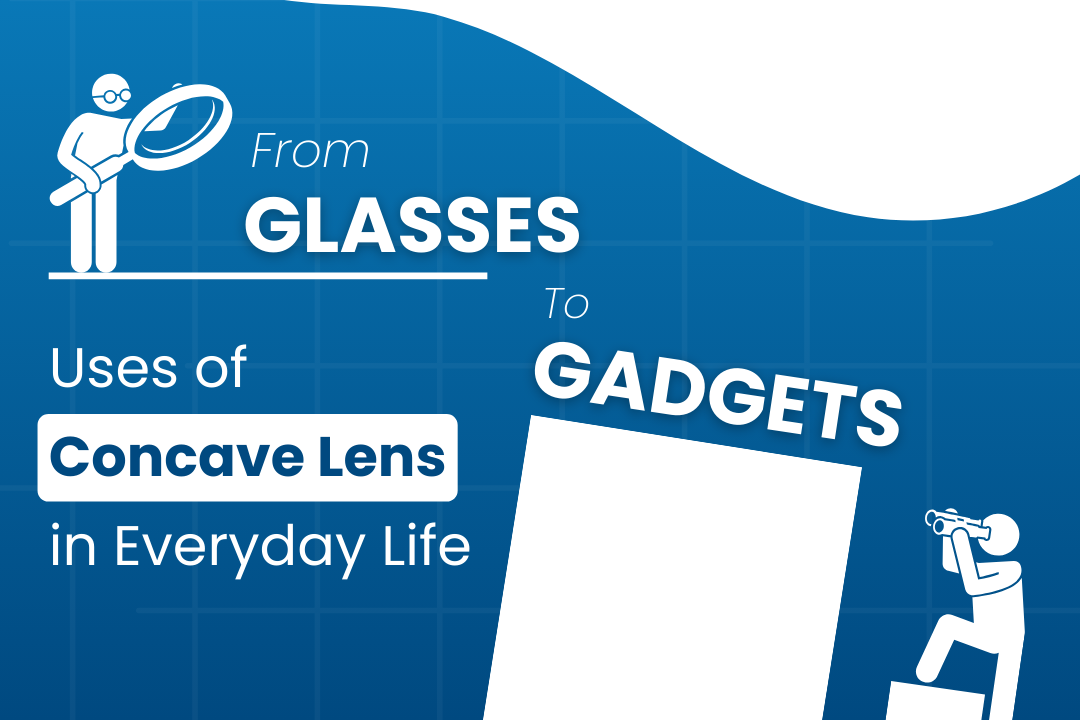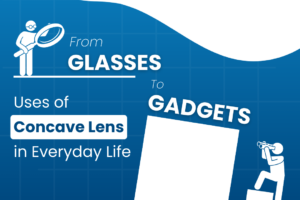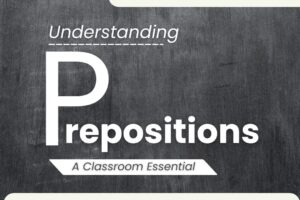
Mirrors and lenses are very important in our daily lives as well as for tenth-class students. Mirrors are used in optical systems for reflection purposes. This is the reason mirrors are used in cameras, microscopes, and telescopes.
Lenses are important for their ability to focus and bend light. They are used in eyeglasses, cameras, and projectors. In the field of physics, lenses are used for understanding the behaviour of light.
Definition of Mirrors and Lenses
Mirrors: Mirrors are surfaces that reflect light in such a way that it preserves many of the detailed physical characteristics of the original light. They are typically made from a glass pane coated with a thin layer of metal such as silver or aluminum. There are different types of mirrors based on their shape and how they reflect light:
- Plane Mirrors
- Concave Mirrors
- Convex Mirrors
Lenses: Lenses are transparent objects, typically made of glass or plastic, that refract (bend) light rays to form an image. They are classified based on their shape and the way they bend light:
- Convex (Converging) Lenses
- Concave (Diverging) Lenses
Principles of Mirrors and Lenses
Now that you know the definition, here are the principles of mirrors and lenses:
3 Principles of Mirrors
- In a plane surface mirror, when parallel beams of light fall, the reflected lights will also be parallel.
- If the surface of the mirror is concave, then the reflected light beams will be convergent.
- If the surface of the mirror is convex, then the reflected light beams will be divergent.
Now, coming to lenses. Lenses are transparent optical devices that work on the principle of refraction. Usually, lenses are made of glass with curved surfaces. When light rays fall on lenses they bend due to the refractive index of the atmosphere and material of the lenses.
3 Principles of Lenses
- A lens can produce focusing effects because light travels more slowly through the lens than the surrounding air.
- A lens has two opposite surfaces; either both are curved, or one is curved and the other is flat.
- The curvature of the lens surfaces is the primary reason, different rays of a light beam are refracted through different angles.
As examples of mirrors and lenses, plain mirrors are used in looking glass, home decors, projectors, shaving mirrors, dentist mirrors, torchlights, solar cookers, periscopes, kaleidoscopes, and automobiles. On the other hand, lenses are used in telescopes, binoculars, cameras, magnifying glasses, eyeglasses, projectors, and solar glasses.
Concave and Convex Mirrors: Definition & Differences
A mirror has two types. One is a plane mirror and the other one is a spherical mirror. A mirror with a plane surface is known as a plane mirror. It creates images that are both virtual and upright.
The spherical mirror is the one that has a curved surface. It is used for creating magnified images. A spherical mirror has two types; one is concave and the other one is convex. Types of concave and convex mirrors we use at home and for other purposes are vehicle headlights, shaving mirrors, solar furnaces, torchlights, flashlights, dental mirrors, microscopes, telescopes, rear-view mirrors, sunglasses, etc.
Definition of Concave and Convex Mirrors
Let’s have a look at the definition of concave and convex mirrors.
- Concave Mirror: The concave mirror’s reflective surface curves inward. The concave mirror is also called a converging mirror.
- Convex Mirror: A convex mirror has a curved surface that bulges outward. In a convex mirror, the outer side is polished, and the inner side is painted. It is also a diverging mirror.
Differences Between Concave and Convex Mirrors
Now, take a look at the 5 differences between concave and convex mirrors.
- The nature of the image for a concave mirror is real and virtual and for a convex mirror, it is virtual only.
- For the concave mirror, the focal length is negative and for the convex mirror, it is positive only.
- The mirror type for the concave mirror is converging while for the convex mirror, it is diverging.
- Mirror coating for the concave mirror is on the outer edge and for the convex mirror, it is on the inner side.
- Concave mirror is used in telescopes, shaving mirrors, and torchlight while convex mirror is used as rear-view mirrors.
Concave and Convex Lenses: Definition & Differences
There are two kinds of lenses: concave and convex. A concave lens has a curved surface. The lens has a concave curvature on its surface. If those surfaces are bent outwards, it is called a biconvex lens or convex lens.
Definition of Concave and Convex Lenses
Let’s have a look at the definition and types of concave and convex lenses.
- Concave Lens: A concave lens is a diverging lens that can spread the beam of light in different directions. People who are facing problems like short-sightedness use concave lenses. Bi-concave, plano-concave and concave-convex are the three primary types of concave lenses. Concave lenses are generally used in spectacles, cameras, lasers, and flashlights.
- Convex Lens: Usually, a convex lens has a thicker middle and a narrower edge. There are three different types of convex lenses, these are Bi-convex, plano-convex and convex-concave lenses. Convex lens is used in telescopes, magnifying glasses, cameras, projectors, and microscopes.
Differences Between Concave and Convex Lenses
Now, take a look at the 5 differences between Concave and Convex lenses.
- For concave lenses, the image formation is virtual; for convex lenses, it is real.
- The focal length of concave lenses is negative and for convex lenses, it is positive.
- For concave lenses, the light will diverge and for convex lenses, it will converge.
- The concave lens has a thick edge and is thin in the middle and for the convex lens, it has a thin edge and is thick in the middle.
- Through concave lenses, objects appear smaller and farther whereas, for convex lenses, objects appear closer and larger.
12 Major Differences Between Mirrors and Lenses
A tenth-grade student can have a look at the 12 prime differences between mirrors and lenses.
| S.No. | Criterion | Mirrors | Lenses |
|---|---|---|---|
| 1. | Optical Law | Law of Reflection | Law of Refraction |
| 2. | Types | 1. Concave 2. Convex 3. Plane | 1. Biconvex 2. Plano-convex 3. Concave-convex 4. Biconcave 5. Plano-concave 6. Convex-concave |
| 3. | Manufacture | Glass or metal | Glass or plastic |
| 4. | Curvature | Plane or Curved | Only Curved |
| 5. | Focal Point | No focal point for the plane mirror. Only one focal point for the spherical mirror. | 2 focal points; F and 2F. |
| 6. | Formula | Image formation. 1/f = 1/v + 1/u f = Focal Length v = Distance of Image u = Distance of Object | Image formation. 1/f = 1/v + 1/u f = Focal Length v = Distance of Image u = Distance of Object |
| 7. | Surface | Only one surface to reflect light. | Two surfaces where either one or both surfaces can reflect light. |
| 8. | Image Formation | Virtual or real images | Real images |
| 9. | Light Path | Reverse direction for light rays | Bends light rays |
| 10. | Dispersion | Not used for color separation | Used for color separation or chromatic aberration |
| 11. | Surface Coating | Uses a reflective coating, made of silver or aluminium on one side of the glass. | Do not apply any type of reflective coating. |
| 12. | Usage | Looking glass, home decors, projectors, shaving mirrors, dentist mirrors, torchlights, solar cookers, periscopes, kaleidoscopes, and automobiles | Telescopes, binoculars, cameras, magnifying glasses, eyeglasses, projectors, and solar glasses |
Conclusion
Despite these differences between mirrors and lenses, both of them execute a primary task and that is producing images of objects that are kept in front of them. The images may vary depending on the position of the object, and they can be real or virtual. Whereas mirrors reflect light, lenses refract the light to form images. In a nutshell, both mirrors and lenses are important for producing different optical functionalities. A tenth-standard student should learn about both mirrors and lenses to understand their features well.








